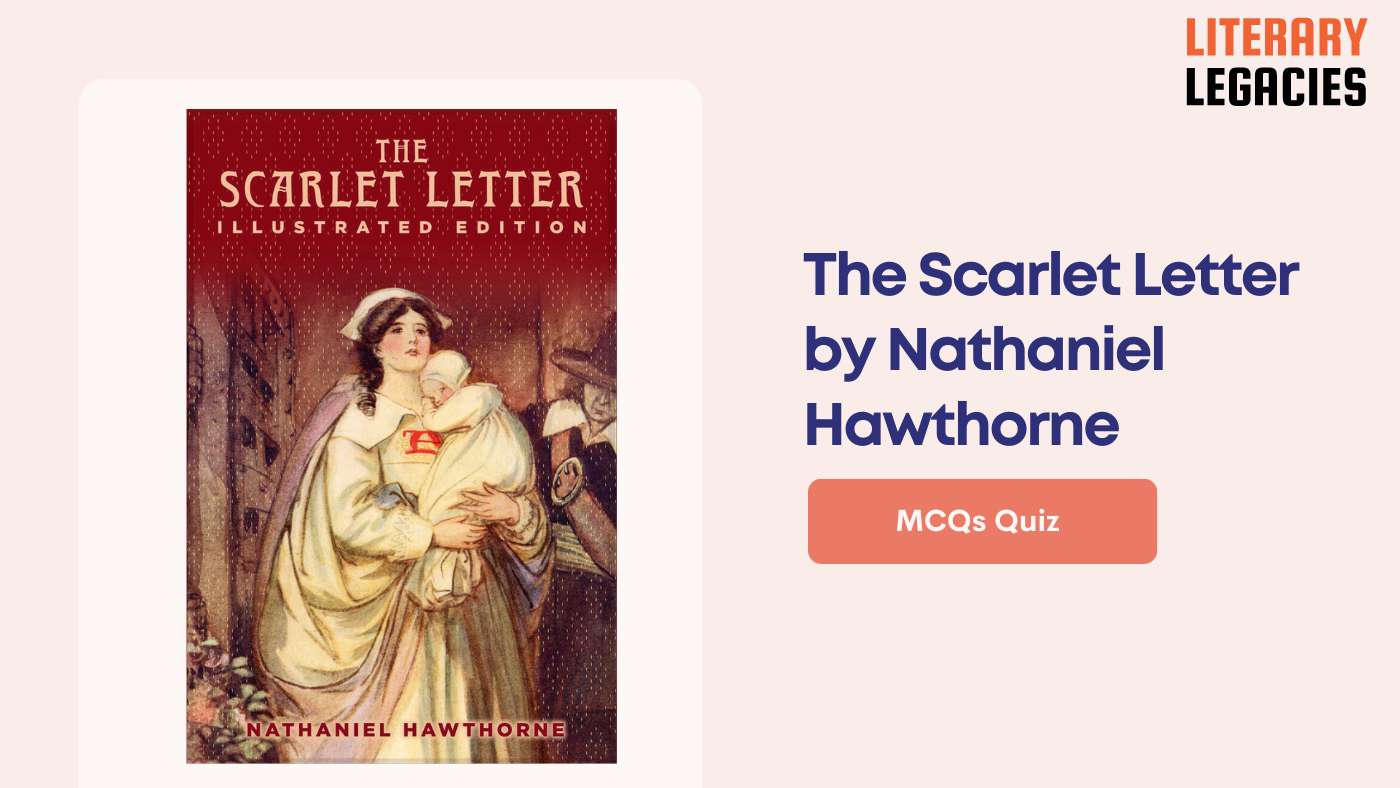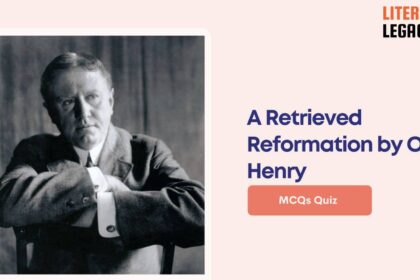1. What is the narrator’s occupation in the custom house?
A. Collector of taxes
B. Town historian
C. Clerk of the court
D. Surveyor
Answer: Surveyor (D)
The narrator’s occupation is revealed in the customhouse preamble.
2. What is the shape of the gold-embroidered patch of cloth found in the customhouse’s attic?
A. A star
B. A heart
C. An ‘A’
D. A circle
Answer: An ‘A’ (C)
The patch of cloth is a significant object that inspires the narrator to write the story.
3. How long before the narrator’s time did the events of the manuscript occur?
A. Four hundred years
B. One hundred years
C. Two hundred years
D. Three hundred years
Answer: Two hundred years (C)
The narrator’s time serves as a frame for the story that takes place in the past.
4. What is the reason for Hester Prynne’s punishment?
A. Adultery and refusal to reveal her lover’s identity
B. Witchcraft and treason
C. Adultery and murder
D. Theft and lying
Answer: Adultery and refusal to reveal her lover’s identity (A)
Hester’s punishment is a public shaming that serves as a reminder of her sin.
5. What is the age difference between Hester and her husband?
A. The age difference is not specified
B. She is much older than he is
C. He is much older than she is
D. They are the same age
Answer: He is much older than she is (C)
Hester’s husband is a significant figure in the story, despite his absence.
6. What is the name of Hester’s infant daughter?
A. Rose
B. Pearl
C. Daisy
D. Lily
Answer: Pearl (B)
Pearl is a symbolically significant character in the story.
7. What is the fate of Hester’s husband, according to the crowd?
A. He is in prison
B. He has abandoned Hester
C. He has been lost at sea
D. He is living in hiding
Answer: He has been lost at sea (C)
The crowd’s consensus serves as a backdrop for the story’s events.
8. What is the significance of the scarlet letter ‘A’ on Hester’s breast?
A. It represents her occupation
B. It represents her husband’s name
C. It represents her sin and her secrecy
D. It represents her social status
Answer: It represents her sin and her secrecy (C)
The scarlet letter is a symbol of Hester’s punishment and shame.
9. What is the occupation of Roger Chillingworth?
A. Seamstress
B. Town Official
C. Physician
D. Minister
Answer: Physician (C)
Chillingworth practices medicine in Boston.
10. What is Hester’s crime, according to the crowd?
A. Witchcraft
B. Adultery
C. Murder
D. Theft
Answer: Adultery (B)
The crowd’s accusation serves as a basis for Hester’s punishment.
11. Why do community officials attempt to take Pearl away from Hester?
A. Because they think Hester is unfit to care for Pearl
B. Because Pearl is a willful child
C. Because Hester is a poor seamstress
D. Because Hester is an outcast
Answer: Because they think Hester is unfit to care for Pearl (A)
The community officials question Hester’s ability to raise Pearl.
12. What is the narrator’s purpose in writing the story?
A. To create a fictional account of the events recorded in the manuscript
B. To reveal the identity of Hester’s husband
C. To condemn the Puritan settlement
D. To bring Hester’s lover to justice
Answer: To create a fictional account of the events recorded in the manuscript (A)
The narrator’s purpose is revealed in the preamble to the story.
13. What is the reason for Arthur Dimmesdale’s mysterious heart trouble?
A. His overwork as a minister
B. His guilt and psychological distress
C. His hatred for Chillingworth
D. His love for Hester
Answer: His guilt and psychological distress (B)
Dimmesdale’s inner torments cause his physical suffering.
14. What does Chillingworth discover on Dimmesdale’s breast?
A. A sign of his illness
B. A scarlet letter
C. A mysterious symbol
D. A mark symbolizing his guilt
Answer: A mark symbolizing his guilt (D)
The exact details of the mark are not revealed to the reader.
15. What is the significance of the meteor marking a dull red ‘A’ in the night sky?
A. It signals the beginning of a new era
B. It is a sign of God’s wrath
C. It is a harbinger of impending doom
D. It symbolizes the community’s judgment
Answer: It symbolizes the community’s judgment (D)
The ‘A’ in the sky echoes the scarlet letter Hester wears.
16. What is Hester’s plan to help Dimmesdale?
A. To publicly shame him
B. To reveal Chillingworth’s identity
C. To leave Boston alone
D. To flee to Europe with him and Pearl
Answer: To flee to Europe with him and Pearl (D)
Hester plans to escape with Dimmesdale and Pearl to start anew.
17. Why does Chillingworth book passage on the same ship as Hester and Dimmesdale?
A. To continue his medical practice
B. To seek a new life in Europe
C. To foil their escape plan
D. To reunite with his family
Answer: To foil their escape plan (C)
Chillingworth seeks to thwart Hester and Dimmesdale’s escape.
18. What happens to Dimmesdale after he confesses publicly?
A. He is imprisoned
B. He dies
C. He is shunned by the community
D. He is forgiven
Answer: He dies (B)
Dimmesdale’s confession is his final act before death.
19. What happens to Hester after Dimmesdale’s death?
A. She leaves Boston with Pearl
B. She is ostracized by the community
C. She returns to her old cottage alone
D. She becomes a minister
Answer: She returns to her old cottage alone (C)
Hester eventually returns to her old life, solo.
20. What is the symbol on the shared tombstone of Hester and Dimmesdale?
A. A cross
B. A pair of doves
C. A scarlet ‘A’
D. A heart
Answer: A scarlet ‘A’ (C)
The tombstone bears the symbol of their shared secret and guilt.
21. What is the central theme in the Judeo-Christian tradition that connects sin and knowledge?
A. The separation between humans and the divine
B. The struggle for power and control
C. The struggle between good and evil
D. The punishment for disobedience
Answer: The separation between humans and the divine (A)
The biblical story of Adam and Eve illustrates the connection between sin and knowledge.
22. What is the outcome of Adam and Eve’s acquisition of knowledge in the biblical story?
A. They gain wisdom and intelligence
B. They become immortal
C. They are expelled from the Garden of Eden
D. They become gods
Answer: They are expelled from the Garden of Eden (C)
Adam and Eve’s expulsion from the Garden of Eden marks a significant turning point in their story.
23. What is the symbolic significance of the tree of knowledge of good and evil in the biblical story?
A. It symbolizes the struggle between good and evil
B. It represents the power of nature
C. It is a symbol of divine authority
D. It represents the source of human wisdom
Answer: It symbolizes the struggle between good and evil (A)
The tree of knowledge serves as a symbol of the moral dilemma faced by Adam and Eve.
24. How does Hester’s experience compare to Adam and Eve’s story?
A. She is punished for her sin like Adam and Eve
B. She gains wisdom and knowledge like Adam and Eve
C. She is also expelled from her community
D. She is forced to toil and procreate like Adam and Eve
Answer: She is punished for her sin like Adam and Eve (A)
Hester’s experience parallels Adam and Eve’s story in that she is punished for her sin.
25. What is the result of Hester’s sin, according to the text?
A. She gains a deeper understanding of herself and her society
B. She becomes morally corrupt
C. She is forced to repent and seek forgiveness
D. She becomes isolated from her community
Answer: She gains a deeper understanding of herself and her society (A)
Hester’s sin leads her to speculate about her society and herself more boldly.
26. What does Dimmesdale’s ‘burden’ give him, according to the text?
A. A sense of authority and power
B. A sense of guilt and shame
C. A sense of moral superiority
D. A sense of empathy with others
Answer: A sense of empathy with others (D)
Dimmesdale’s sin gives him a sense of empathy with the sinful brotherhood of mankind.
27. What is the attitude of the Puritan elders towards earthly experience?
A. They see it as a means to achieve spiritual enlightenment
B. They think it is a source of human knowledge
C. They believe it is a test of moral character
D. They view it as an obstacle on the path to heaven
Answer: They view it as an obstacle on the path to heaven (D)
The Puritan elders view earthly experience as merely an obstacle on the path to heaven.
28. What is the result of Hester and Dimmesdale’s contemplation of their own sinfulness?
A. They become morally corrupt
B. They become more isolated from each other
C. They reconcile their sin with their lived experiences
D. They seek forgiveness from the community
Answer: They reconcile their sin with their lived experiences (C)
Hester and Dimmesdale try to reconcile their sin with their lived experiences.
29. What is the symbolic significance of the scarlet letter ‘A’ on Hester’s breast?
A. It serves as a warning to others
B. It symbolizes Hester’s sin and shame
C. It is a symbol of divine authority
D. It represents Hester’s purity and innocence
Answer: It symbolizes Hester’s sin and shame (B)
The scarlet letter ‘A’ is a symbol of Hester’s sin and shame.
30. How does Hester’s experience compare to the story of Adam and Eve in terms of knowledge?
A. Both result in a deeper understanding of human nature
B. Both involve a physical punishment
C. Both involve a moral dilemma
D. Both are punished for disobedience
Answer: Both result in a deeper understanding of human nature (A)
Both Hester’s experience and the story of Adam and Eve involve a gain in knowledge about human nature.
31. What is the main reason why Hester does not leave the Massachusetts Bay Colony after being shamed?
A. She wants to determine her own identity rather than letting society determine it for her.
B. She is waiting for her husband to return.
C. She is physically imprisoned and has no choice.
D. She wants to prove a point to the Puritan community.
Answer: She wants to determine her own identity rather than letting society determine it for her. (A)
Hester’s desire to control her own identity drives her decision to stay.
32. What is the outcome of Hester’s decision to follow her heart and have sex with a man she is not married to?
A. She becomes more independent and self-sufficient
B. She gets punished by the community
C. She loses touch with her moral principles
D. She gets married to the man
Answer: She gets punished by the community (B)
This decision is seen as a violation of the social norms
33. What is the true nature of evil, according to the novel?
A. It is found in Hester and Dimmesdale’s lovemaking.
B. It arises from the strict adherence to Puritan values.
C. It is a product of the close relationship between hate and fear.
D. It results from the careful plotting and precise aiming of revenge.
Answer: It results from the careful plotting and precise aiming of revenge. (D)
The novel argues that true evil arises from the perverted love of Chillingworth.
34. Why is Hester reluctant to remove the scarlet letter?
A. She is afraid of what others will think of her.
B. She sees it as a symbol of her own experiences and character.
C. She is proud of her sin and wants to flaunt it.
D. She is forced to wear it as a punishment.
Answer: She sees it as a symbol of her own experiences and character. (B)
Hester refigures the scarlet letter as a symbol of her own experiences and character.
35. What does the narrator suggest about Hester’s independence?
A. It makes her unhappy
B. It comes at a high price
C. It prevents her from raising a happy child
D. It leads to complete freedom from social expectations
Answer: It comes at a high price (B)
Her independence comes at the cost of losing touch with key ethical principles
36. What is the implication of Pearl’s character in the novel?
A. Pearl is a symbol of purity
B. Female independence is antithetical to happiness
C. Pearl is a symbol of sin
D. Female independence can lead to happiness
Answer: Female independence is antithetical to happiness (B)
Pearl’s character suggests that independence is not essential for happiness
37. What is the outcome of Hester’s sin, according to the novel?
A. It leads to the glorification of sin.
B. It leads to personal growth, sympathy, and understanding of others.
C. It leads to stagnation and punishment.
D. It leads to the downfall of society.
Answer: It leads to personal growth, sympathy, and understanding of others. (B)
Hester and Dimmesdale’s experience shows that a state of sinfulness can lead to personal growth.
38. What is Dimmesdale’s struggle, according to the novel?
A. He struggles against his own sin.
B. He struggles against the Puritan community’s values.
C. He struggles against his own identity.
D. He struggles against a socially determined identity.
Answer: He struggles against a socially determined identity. (D)
Dimmesdale struggles against a socially determined identity as the community’s minister.
39. What is the primary source of guilt for Arthur Dimmesdale?
A. His holy and righteous nature
B. His sinful act of fathering an illegitimate child
C. His failure to take public responsibility for his actions
D. His public veneration by the community
Answer: His sinful act of fathering an illegitimate child (B)



